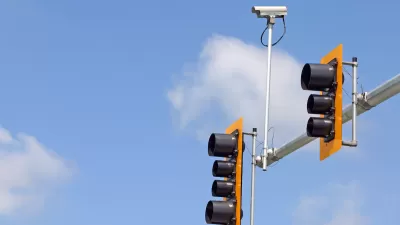Recommendations for how USDOT can guide more equitable traffic enforcement that improves traffic safety and protects vulnerable populations.

A report from the Center for American Progress, Vera Institute of Justice, and Color Of Change outlines recommendations for the U.S. Department of Transportation (USDOT) that could reduce racial discrimination in traffic enforcement.
The four reforms are:
- “Enhancing performance measurement and data collection pursuant to formula grants,” ensuring that traffic safety and enforcement data is public and available.
- “Leveraging discretionary grants to support state and local innovation.”
- “Bridging the research gap” to better understand the relationship between public safety, enforcement, and equity.
- “Engaging directly affected communities and uplifting innovations to amplify successes.” This includes recognizing the harms already caused and including vulnerable communities in conversations about public safety.
According to the CAP, “Low-level traffic stops create fear in communities, which further erodes trust in the law enforcement. We believe these recommendations will provide the steps needed to achieve progress in both racial equity and road safety.”
FULL STORY: RELEASE: 4 Ways the U.S. Department of Transportation Can Combat Racially Biased Police Traffic Enforcement

Maui's Vacation Rental Debate Turns Ugly
Verbal attacks, misinformation campaigns and fistfights plague a high-stakes debate to convert thousands of vacation rentals into long-term housing.

Planetizen Federal Action Tracker
A weekly monitor of how Trump’s orders and actions are impacting planners and planning in America.

In Urban Planning, AI Prompting Could be the New Design Thinking
Creativity has long been key to great urban design. What if we see AI as our new creative partner?

How Trump's HUD Budget Proposal Would Harm Homelessness Response
Experts say the change to the HUD budget would make it more difficult to identify people who are homeless and connect them with services, and to prevent homelessness.

The Vast Potential of the Right-of-Way
One writer argues that the space between two building faces is the most important element of the built environment.

Florida Seniors Face Rising Homelessness Risk
High housing costs are pushing more seniors, many of them on a fixed income, into homelessness.
Urban Design for Planners 1: Software Tools
This six-course series explores essential urban design concepts using open source software and equips planners with the tools they need to participate fully in the urban design process.
Planning for Universal Design
Learn the tools for implementing Universal Design in planning regulations.
Gallatin County Department of Planning & Community Development
Heyer Gruel & Associates PA
JM Goldson LLC
City of Camden Redevelopment Agency
City of Astoria
Transportation Research & Education Center (TREC) at Portland State University
Jefferson Parish Government
Camden Redevelopment Agency
City of Claremont





























